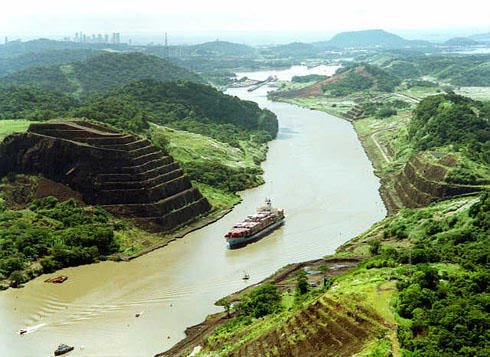The Panama Canal
1914 The first ship to pass through the canal (SS Ancon)
In 1869, Suez Canal was completed: this is where the idea for the Panama Canal began
1881 Ferdinand de Lesseps starts work on the Canal
1884 French have over 19,000 working on the Canal project
1881-1889 Disease runs rampant: Malaria, Yellow Fever and Typhoid (death toll: 22,000)
1889 de Lesseps’ can no longer manage the financial aspects of the project and he declares bankrupcy
1894 New French Company attempts to restart the venture, but is unsuccessful (retain ownership)
1898 Americans send battleship Oregon around South America to aid attack against Cuba in Spanish American War (thus an understanding of the importance of a canal project)
1902 Roosevelt Administration decides to make a trans-oceanic canal a national priority
1903 “Panamanians” (very minor group, encouraged by International Interests) revolt from Columbia and declare independence; US maintains rights to Canal
1904 John F. Wallace named first American Chief Engineer
1905 John F. Stevens succeeds Wallace and introduces plans for a LOCK system with Gatun Lake included in pathway
1906 Army Engineer COL George W. Goethals succeeds Stevens and essentially completes his plan, overcoming enormous health and landslide problems
August 1914 the first vessel transits the new Panama Canal, just as World War I erupts
Life for Workers
Streets and areas were without sewage and water. This is an example of a street before American occupation and then after.
Workers were shipped in from all over the world. Housing and food was provided with wages (but weren’t very high)
Quarantine for a Yellow Fever victim
Fighting Mosquitoes (Disease)
The canal could not be completed until sanitation problems were solved (Dr. William Gorgas took upon himself the cause of discovering and then fighting the transfer of disease.)
The Big Cut at Culebra
One of the largest and most difficult incisions was along the Continental Divide near Culebra, where they had to cut through volcanic rock
Culebra Cut had numerous landslides, requiring more than 5 times the original excavation.
Engineering challenges and solutions that had never been done before in every aspect of the Canal’s development
The impossible was tried: mechanically, financially, medically, and geographically
To handle the millions of tons of stone, sand, and cement required for building the locks, ingenious machinery has been installed which automatically selects the right proportions of stone, sand, and cement and mixes the material. The piles in the foreground in the above picture are sand; the darker piles on the further side of the railway track are stone. Grab-buckets shoot down from the arms of the crane, bite into the piles, shoot back to the crane, and feed their loads into the mixer, where cement has been already delivered in bags or barrels.)

No comments:
Post a Comment